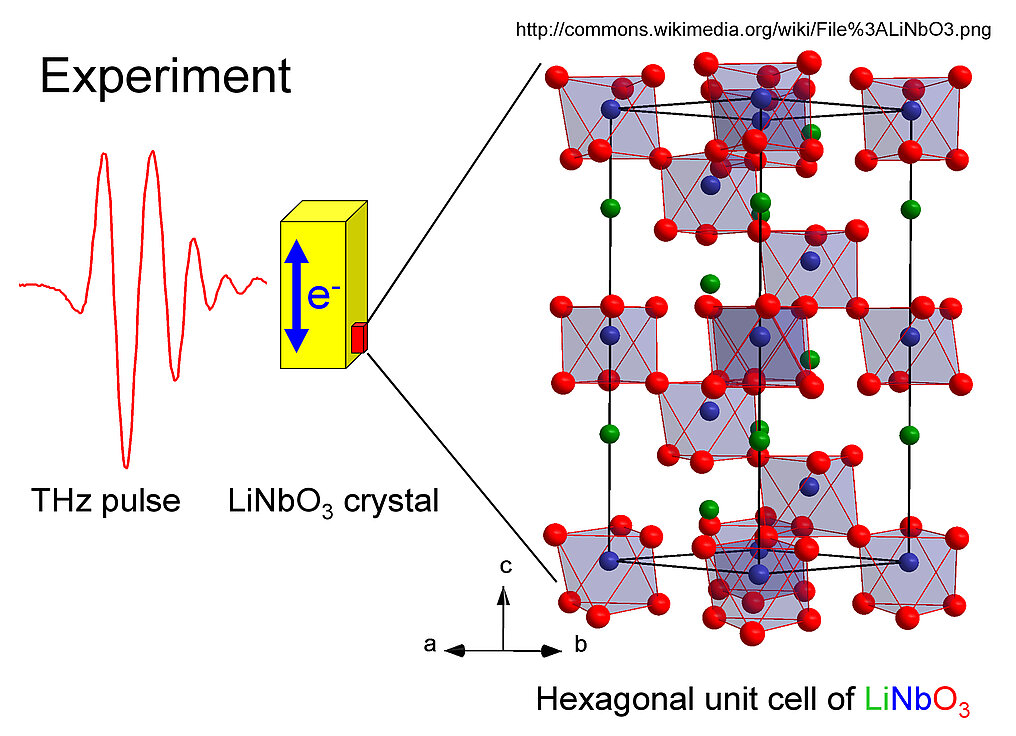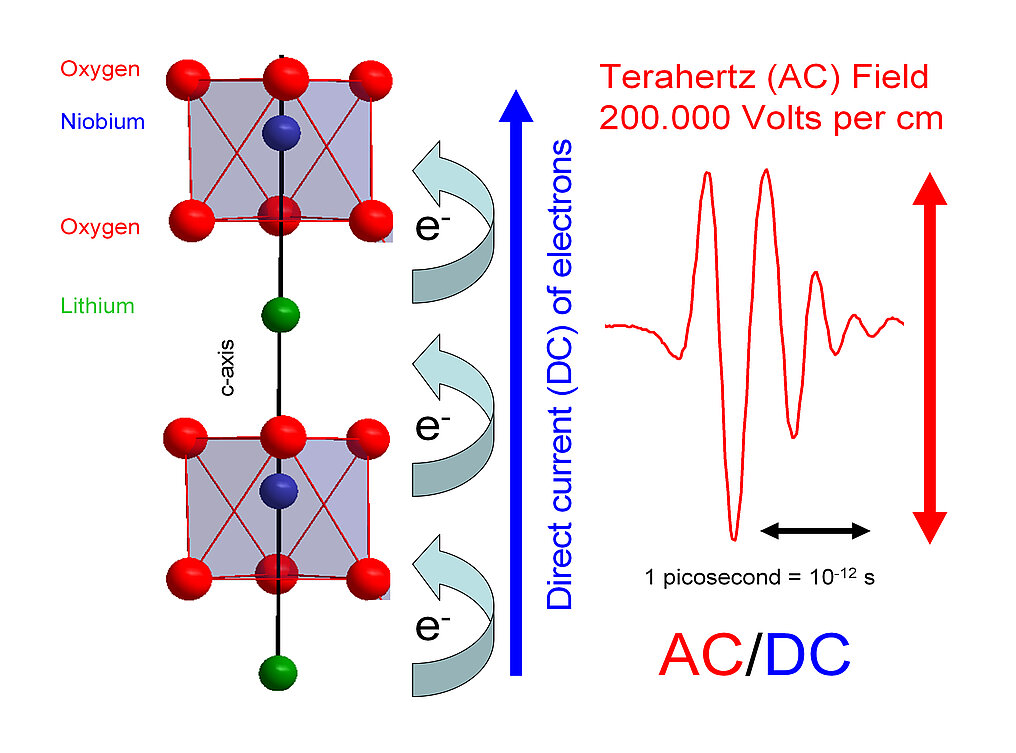When guitarist Angus Young of the Australian band AC / DC plucks the strings of his electric guitar, a very distorted rocking sound is created in the loudspeaker. The cause of the electronically generated harmonics is the rectifier effect in the electron tubes of the guitar amplifier. In the simplest case, an alternating current [(A) alternating (C )urrent] produces a direct current [(D) irect (C )urrent], an effect which finds technical application in telecommunications at much higher radio or mobile phone frequencies. Physically very interesting is the question up to which cut-off frequencies one can generate directed direct currents in solid materials and which mechanisms are behind them.
AC/DC for terahertz waves - rectification in picosecond cycle

Fig. 1 Experiment: The high electric field of a terahertz pulse accelerates the electrons in a lithium niobate (LiNbO3) crystal. The hexagonal unit cell contains lithium atoms (green spheres), niobium atoms (blue spheres), and oxygen atoms (red spheres) located around the corners of an octahedron around the niobium atoms. The crystal has no inversion symmetry and therefore a ferroelectric polarization along the c-axis.
For the generation of DC from alternating currents, the material used must have a preferred direction. This condition is met by ferroelectric crystals in which the spatial separation of positive and negative ions is associated with electrical polarization. Most ferroelectrics are electrical insulators, i. with small externally applied electric fields almost no electric current flows through them. This behavior changes drastically when you apply a very strong electric field in the range of several 100,000 volts per centimeter for a short time. At such field strengths, bound electrons, so-called valence electrons, can be made freely movable for a short time by means of a quantum-mechanical tunneling process and therefore lead to a current through the crystal.
Fig. 2 When transporting electrons along the c-axis, they have to overcome alternating distances between lithium and niobium atoms. The niobium atoms in turn are not in the center of the oxygen octahedron. Both lead to asymmetric barriers (see Movie), which can only overcome the electrons by means of the quantum mechanical tunneling process. Very high alternating electric fields (AC) drive the electrons through the tunnel barriers. The asymmetry of the barriers along with decoherence lead to a spatially asymmetric transport, i. on a sub-nanometer length scale, the terahertz field causes a direct current (DC) in the LiNbO3 crystal.
The properties of such a current were first investigated by researchers at the Max Born Institute in Berlin, about which they report in the current issue of the journal Physical Review Letters 112.146602. In the form of ultrashort intense terahertz pulses (1 terahertz = 1012 Hz, duration of field vibration 1 picosecond = 10-12 seconds), an AC field was applied to a thin crystal of lithium niobate (LiNbO3), which generates an electrical current in the material , The properties of this current were determined by measuring and analyzing the field it radiated. In addition to an oscillating current that had the frequency of the applied terahertz field (2 THz) and many of them, the researchers also saw the signature of a rectified (DC) current along the ferroelectric preferred direction of the LiNbO3 crystal.
Asymmetric tunneling probability due to an asymmetric barrier in the presence of decoherence processes: The tunnel barrier (black curves) passes more electrons from right to left than in the opposite direction. A wave packet (red curves) is largely reflected at the barrier. Only a small part (marked by red diamonds) can tunnel through the barrier quantum mechanically. Its size depends on the traversal direction in the case of decoherence. For comparison, the dashed blue curves show the motion of wave packets in the absence of the tunnel barriers.
The rectified current along the ferroelectric axis has its origin in the interaction of quantum mechanical tunneling between the valence and various conduction bands of the LiNbO3 crystal and the deceleration of the electrons by friction processes. The tunneling process generates freely moving electrons that would oscillate spatially and temporally without friction in time with the applied terahertz field. Friction destroys this vibratory motion, a process called decoherence. Since the tunnel barrier of LiNbO3 is asymmetric along the ferroelectric axis, decoherence results in spatially asymmetric transport, i. The tunnel barrier allows more electrons from right to left than in the opposite direction. This mechanism is within a unit cell of the crystal, i. on a sub-nanometer length scale and causes the rectification of the terahertz field. The effect can be exploited even at even higher frequencies resulting in interesting applications in the highest frequency electronics.
Search publications of MBI
Publications since 2025
